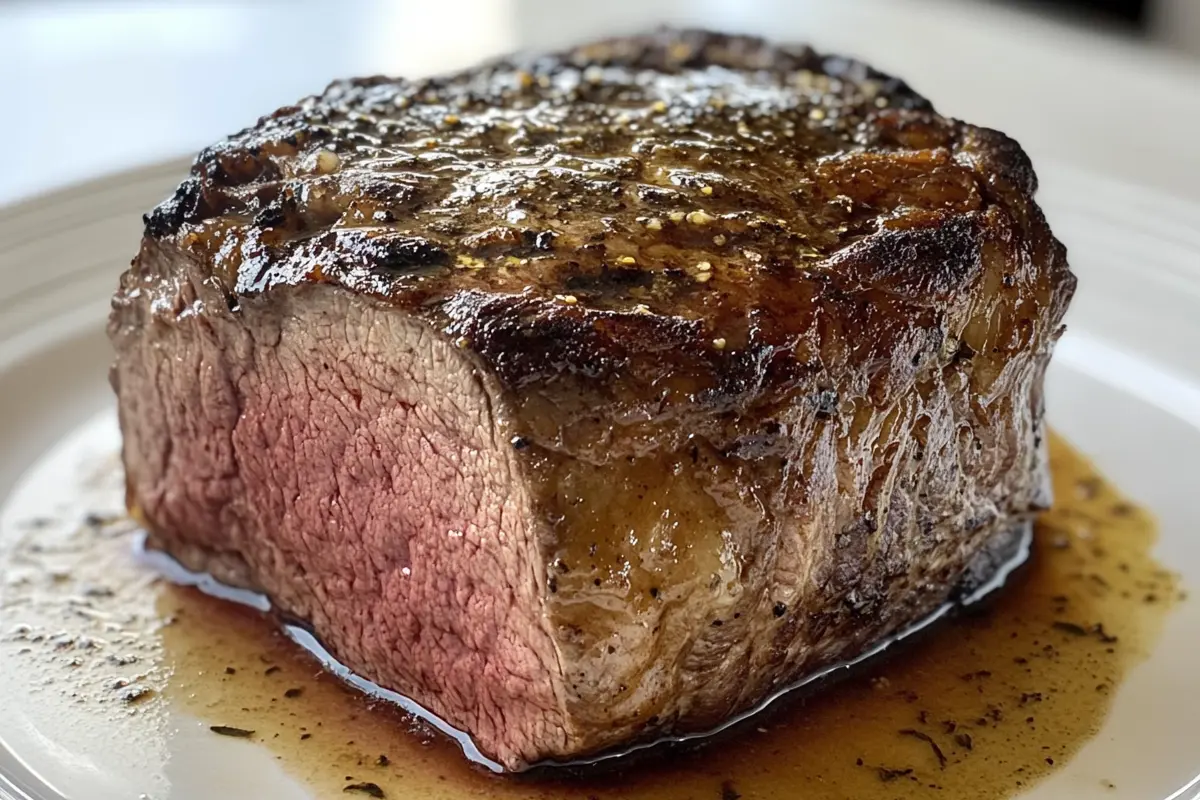
What is Prime Rib of Beef?
Understanding Prime Rib
Prime Rib of Beef refers to a specific cut of beef that comes from the rib section of the cow. Also known as a standing rib roast, it’s one of the most flavorful and tender cuts, thanks to its natural marbling of fat. This cut is usually cooked with the bone in, which not only adds to the flavor but also helps to retain moisture during cooking.
What sets prime rib apart from other beef roasts is its luxurious texture and rich beefy flavor. The term “prime” actually refers to the quality of the beef, with prime being the highest grade assigned by the USDA. However, even if you can’t find USDA prime-grade beef, the cut itself—whether it’s labeled as choice or select—will still deliver exceptional results when cooked properly.
Why Prime Rib is a Special Cut
One of the reasons prime rib is such a prized cut is due to its tenderness and marbling. The marbling—thin lines of fat interspersed throughout the meat—melts as the roast cooks, keeping the beef juicy and flavorful. The rib section of the cow also provides an ideal balance of fat and meat, making each bite succulent and satisfying.
The name standing rib roast comes from the traditional way of roasting the cut with the bones upright, allowing the heat to circulate evenly around the meat. This method results in a beautifully seared crust while keeping the interior tender and juicy. The combination of rich flavor, tenderness, and impressive presentation makes Prime Rib of Beef a popular choice for festive dinners and celebrations.
Selecting the Best Prime Rib Cut
Choosing the right cut of prime rib of beef is essential for a delicious and tender roast. While this cut is generally high-quality by nature, there are a few key factors to consider when selecting the best one for your recipe. Let’s break down the different grades and types of prime rib to help you make the best choice.
Choosing the Right Cut for Your Prime Rib Recipe
Prime, Choice, or Select Grades
When buying prime rib, you’ll often see it labeled as Prime, Choice, or Select, referring to the USDA grading system. Here’s how each grade affects your roast:
- Prime Grade: This is the top tier of beef quality, with the most marbling and tenderness. Prime beef is rare in grocery stores and usually found at specialty butchers. If you can find prime-grade meat, it’s worth the splurge, especially for special occasions. The marbling ensures a juicier, more flavorful roast.
- Choice Grade: The most commonly available grade, choice still offers good marbling but not as much as prime. This grade is an excellent balance of quality and affordability, providing great flavor and tenderness at a more accessible price point.
- Select Grade: This is the leanest of the three grades and will have less marbling, which means it could be less tender. While it’s less ideal for prime rib, careful cooking can still yield good results if this is the only option available.
Bone-In vs. Boneless Prime Rib
When choosing your cut, you’ll also need to decide between bone-in and boneless prime rib:
- Bone-In Prime Rib: Keeping the bone in your roast adds extra flavor and helps insulate the meat during cooking, making it juicier. The bones can also act as a natural rack, lifting the roast off the pan and allowing heat to circulate evenly. While carving can be a bit more challenging, the rich flavor is often worth it.
- Boneless Prime Rib: This option is easier to carve and tends to cook a little faster. However, boneless roasts may lose a bit of the depth of flavor that the bones provide. If you’re prioritizing ease of preparation, boneless is a good option and still delivers an excellent roast.
If you choose a bone-in roast, ask your butcher to French the bones, which means trimming the meat around the ends of the bones for a cleaner presentation.
How Much Prime Rib to Buy
A key question when planning your meal is how much prime rib to buy. The general rule of thumb is:
- For a bone-in roast, plan for 1 pound per person.
- For a boneless roast, plan for 3/4 pound per person.
If you’re hoping for leftovers (and trust me, leftover prime rib makes fantastic sandwiches!), you may want to add an extra pound or two to your total. Leftover prime rib keeps well and can be easily reheated without losing its tenderness.
Ingredients:
1 (5-6 lb) prime rib roast (bone-in)
3 tbsp olive oil
1 tbsp black pepper
6 garlic cloves, minced
2 tbsp fresh rosemary, chopped
2 tbsp fresh thyme, chopped
1 tbsp coarse salt
1 cup beef broth or red wine (for the pan)
Instructions:
Prepare the roast: Remove the prime rib from the fridge about 1 hour before cooking to bring it to room temperature. Preheat your oven to 450°F (230°C).
Season the meat: In a small bowl, mix olive oil, minced garlic, rosemary, thyme, salt, pepper, and Dijon mustard (if using). Rub this mixture all over the prime rib, ensuring it’s evenly coated.
Roast the prime rib: Place the prime rib on a roasting rack in a large roasting pan. Pour beef broth or red wine into the bottom of the pan to prevent drippings from burning.
Lower the temperature: Reduce the oven temperature to 325°F (160°C) and continue roasting for about 2 hours, or until the internal temperature reaches 120°F (49°C) for medium-rare. Use a meat thermometer to check for doneness.
Carve and serve: Slice the prime rib into thick, juicy slices and serve with the pan drippings, horseradish sauce, or au jus.
Helpful Tips:
For rare, aim for an internal temperature of 115°F (46°C); for medium, 130°F (54°C).
Letting the roast rest after cooking is crucial for juicy, tender meat.
How to Cook Prime Rib of Beef
Now that your prime rib is seasoned and prepped, it’s time to cook it to perfection. There are several methods you can use, depending on the texture and flavor you’re aiming for. In this section, we’ll cover the most popular roasting techniques, including the low-and-slow method, the high-heat blast, and a combination of both. By following these steps, you’ll achieve a juicy interior with a beautifully crisp crust.
The Perfect Prime Rib Cooking Techniques
Low-and-Slow Roasting Method
The low-and-slow method is perfect if you want to ensure an even cook throughout the roast, especially if you’re aiming for that consistent pink, tender center. Here’s how to execute this technique:
- Preheat your oven to 250°F (120°C).
- Place the prime rib on a roasting rack inside a large pan. The rack allows air to circulate under the meat, ensuring even cooking.
- Roast the prime rib for approximately 25-30 minutes per pound, depending on your desired level of doneness:
- 120°F (49°C) for rare
- 130°F (54°C) for medium-rare
- 140°F (60°C) for medium
Keep a close eye on the temperature with your meat thermometer, and remove the roast from the oven when it reaches 5°F below your target temperature. This allows for carryover cooking, which brings the roast to the perfect doneness while it rests.
High-Heat Blast Method
If you prefer a crispy crust and don’t mind the inside having a more pronounced gradient of doneness, the high-heat blast method is for you. This method involves cooking the roast at a high temperature for a shorter period. Here’s how:
- Preheat your oven to 450°F (230°C).
- Place the seasoned prime rib on a roasting rack inside the pan.
- Roast the beef for 15 minutes at 450°F to develop a crust, then reduce the temperature to 325°F (160°C).
- Continue roasting for about 13-15 minutes per pound until the internal temperature reaches your preferred doneness (use the same internal temperature guidelines as the low-and-slow method).
- Remove from the oven when it’s 5°F below your target temperature.
The high-heat start creates that desirable golden-brown exterior, while the lower temperature finishes the cooking gently, so the inside stays tender.
Combination Cooking: The Best of Both Worlds
For the ultimate prime rib experience, consider using a combination of both methods. This approach gives you the best of both worlds—an evenly cooked interior with a beautifully crispy crust. Here’s how:
- Start with the low-and-slow method: Preheat the oven to 250°F (120°C) and cook the roast until the internal temperature is about 10°F below your target.
- Once the roast reaches this temperature, remove it from the oven and let it rest for 20-30 minutes.
- Just before serving, blast it at 500°F (260°C) for 5-10 minutes to crisp up the exterior.
This method ensures that the interior remains perfectly tender and evenly cooked, while the exterior gets that perfect, golden-brown crust.
Prime Rib Cooking Time Chart
Here’s a handy chart to help you determine cooking times based on the size of your roast and the level of doneness you want:
| Doneness | Internal Temperature | Cooking Time (Per Pound) |
|---|---|---|
| Rare | 120°F (49°C) | 25-30 minutes (low-and-slow) |
| Medium-Rare | 130°F (54°C) | 15-20 minutes (high heat) |
| Medium | 140°F (60°C) | 13-15 minutes (combination) |
Resting the Prime Rib
Once your prime rib reaches the desired internal temperature, it’s important to let it rest. Resting allows the juices to redistribute throughout the meat, making each slice tender and flavorful.
- Cover the roast loosely with foil to keep it warm and let it rest for at least 20-30 minutes.
- During this time, the internal temperature will rise another 5-10°F due to carryover cooking, bringing it to the perfect doneness.
By following these cooking techniques, you’ll achieve a roast that’s juicy, tender, and full of flavor. for more

